Providence Park
Providence Park (formerly Jeld-Wen Field; PGE Park; Civic Stadium; originally Multnomah Stadium; and from 1893 until the stadium was built, Multnomah Field)[1] is an outdoor soccer venue in the northwest United States, located in the Goose Hollow neighborhood of Portland, Oregon. It has existed in rudimentary form since 1893, and as a complete stadium since 1926. Providence Park is currently the oldest soccer-specific stadium in use in MLS and is one of the most historic grounds used by any United States professional soccer team.
 | |
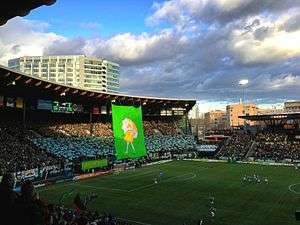 The Timbers Army displays a tifo before a match. | |
 Providence Park Location in Portland  Providence Park Location in Oregon  Providence Park Location in the United States | |
| Former names | Multnomah Field (1893–1926)[1] Multnomah Stadium (1926–1965) Civic Stadium (1966–2000) PGE Park (2001–2010) Jeld-Wen Field (2011–2014) |
|---|---|
| Address | 1844 SW Morrison |
| Location | Portland, Oregon |
| Coordinates | 45°31′17″N 122°41′30″W |
| Public transit | ■ Red Line ■ Blue Line at Providence Park |
| Owner | City of Portland |
| Operator | Peregrine Sports, LLC |
| Capacity | 25,218 |
| Field size | 110x75 yards[2] |
| Surface | FieldTurf Revolution |
| Construction | |
| Broke ground | May 6, 1926[3] |
| Opened | October 9, 1926[4] |
| Renovated | 1956, 1982, 2001, 2011, 2019 |
| Construction cost | $502,000 ($7.25 million in 2019 dollars[5]) $36 million (2010 Renovation) ($40.9 million in 2019 dollars[5]) $85 million (2018-19 Renovation)[6] ($85 million in 2019 dollars[5]) |
| Architect | A. E. Doyle Morris H. Whitehouse & Associates |
| General contractor | Hansen-Hammond Company[7] |
| Tenants | |
Portland Timbers (MLS) (2011–present)
Portland State Vikings football (NCAA) (1947–1999, 2001–2009, 2011–2017)
Portland Mavericks (NWL) (1973–1977) Portland Rockies (NWL) (1995–2000) | |
| Website | |
| http://providenceparkpdx.com/ | |
Two professional soccer teams, the Portland Timbers of MLS and Portland Thorns FC of NWSL, use the facility as their home pitch. The stadium has been host to several major United States soccer events including Soccer Bowl '77, the 1999 and 2003 FIFA Women's World Cups, the 2013 CONCACAF Gold Cup, the 2014 MLS All-Star Game and the 2015 NWSL Championship Game. Providence Park has been the home of the Portland Timbers since 1975.
The Portland-based Multnomah Athletic Club was founded in 1891 and soon constructed the stadium for their amateur sports teams beginning in 1893. In 1926, the facility was expanded into a complete stadium, including the upper seating bowl and the wooden benches which can still be found in the park. In 1956, the stadium was renovated in earnest for the first time to reflect its growing usage in the community and in 1966, the city purchased the stadium and renamed it Civic Stadium. It was renovated in 2001 to accommodate the Timbers and the Portland Beavers, while the naming rights of the stadium were purchased by Portland General Electric and it was renamed PGE Park. In 2011, the park underwent renovations again, this time so it could accommodate the Portland Timbers MLS franchise and a year later the stadium name rights were sold, this time to Jeld-Wen (Jeld-Wen Field). In 2014, the name was changed again to Providence Park after Providence Health & Services bought the naming rights.[8]
A 2019 expansion raised the capacity to 25,218 and added a multi-level facade to the East Side. The Portland Timbers have sold out every single game at Providence Park since moving to MLS in 2011, and the Thorns set a single-game National Women's Soccer League attendance record in August 2019 with a sell-out crowd of the same capacity.[9] In 2019, both clubs ranked among the top ten in attendance among professional soccer teams (men's or women's) in the United States and Canada.[9]
Description
Providence Park is an outdoor soccer stadium which houses the MLS Portland Timbers and NWSL Portland Thorns. The stadium is owned by the City of Portland, and is managed by Peregrine Sports, LLC, the entity that owns the Timbers and Thorns.
The stadium sits on a rectangular block bounded by Southwest Morrison Street, Southwest 18th Avenue, the Multnomah Athletic Club building and Southwest Salmon Street, and Southwest 20th Avenue.[10][11]
The Multnomah Athletic Club, an athletic club in downtown Portland which originally constructed the venue, stands next door; the windows of the north side of the club's building overlook the field.
The Interstate 405 freeway in Portland is also known locally as the Stadium Freeway and travels near the stadium. In addition, the Providence Park MAX Light Rail station is across the street. The property slopes significantly downhill from the south end to the north end, with the result that the playing surface sits well below street level. The elevation at street level is approximately 110 feet (35 m) above sea level.
History
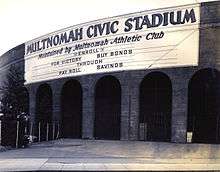
Since 1893, the site had been home to Multnomah Field, which consisted of sports fields with various grandstands.[12][13] Before the MAC developed the site as an athletic field, it was a large Chinese vegetable garden, supplying produce to much of Portland.[14] In 1912, the distinctive Multnomah Athletic Club, which currently borders the south end of the stadium, was constructed. The overarching stadium was completed in 1926 for $502,000, and named Multnomah Civic Stadium after the club.[15]
The site was used for college football (including seven Civil War games between the University of Oregon and Oregon State University), cricket matches and greyhound racing. Well into the 1960s, most significant football games hosted by Oregon and Oregon State were held at this site because of its capacity. Oregon played in 107 games at Multnomah/Civic Stadium between 1894 and 1970. The University of Washington played all its road games against Oregon and Oregon State at Multnomah Field/Multnomah Stadium until 1966 (OSU) and 1967 (Oregon). The site also hosted the Portland Rose Festival coronation and appearances by Presidents William Howard Taft and Warren G. Harding.[12]
In 1956, the Portland Beavers moved to the stadium after their original field, Vaughn Street Park, was condemned. In 1966, the Multnomah Athletic Club sold the stadium for $2.1 million to the city of Portland, which renamed it Civic Stadium.[12][15][16]
Prior to the 2011 MLS season, the stadium was renamed Jeld-Wen Field from PGE Park, in a partnership with Klamath Falls-based company Jeld-Wen. Jeld-Wen is a manufacturer of windows and doors, leading to the stadium's nickname, "The House of Pane." In 2014, the stadium was renamed Providence Park after a partnership with Providence Health & Services was announced.[8]
Renovations
1956
The first major renovation to Providence Park after its full construction in 1926 came in 1956, when the Portland Beavers moved to what was then called Multnomah Stadium, from the dilapidated cross-town Vaughn Street Park. For the first time, permanent east side seating was constructed, as well as a large ticketed section in the southeast corner of the stadium. The east side seats were all constructed above an outfield wall, and box seats were built in the stadium for the first time. Along with the expansion came the demolition of the greyhound racing track, which was constructed in 1933.[17]
1982
In November 1980, Portland voters passed a ballot measure that provided the city (who had owned the stadium since 1966) with a much-needed $9.5 million to improve the foundation, concourse and replace the roof.[18] The money allowed the city to replace the aging roof, adding an extended roofline out of laminated Oregon timber. The new roof covered a much higher percentage of seats and included the construction of a new press box, which was finished by winter 1982.
2001
In November 2000, the Portland City Council authorized bonds to finance a renovation of then-Civic Stadium.[19] A $38.5 million renovation took place in 2001, upgrading the seating and concourse area, and adding new luxury suites and club seats. The renovation improved the structural soundness of the facility by adding over 750 tons of steel, and introduced a new sound system. The renovation also included some retro-features, such as a manually operated baseball scoreboard. At that point, PGE bought the naming rights and it became PGE Park.[16]
The 2001 renovation also removed the remaining outfield seats along 18th Avenue and added in the first electronic video board in the park, modernizing the park for soccer and minor-league baseball.[20]
2011
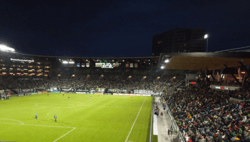
In July 2009, after attempts to both find a new home for an MLS franchise and identify a site for a new home for the Portland Beavers, the Portland City Council approved a $31 million renovation to make PGE Park ready for the 2011 Major League Soccer season, by reconfiguring the stadium primarily for soccer and football.[21][22] The decision led to the departure of the Beavers.
The renovation was performed by Turner Construction, who served as the general contractor and also performed the 2001 renovation, and Ellerbe Becket as the primary architect. A presentation to the Portland Design Commission indicated that 5,000 seats would be added, bringing capacity to about 22,000, but with only about 18,000 available for use on a regular basis.[23]
The renovation met Major League Soccer standards, introduced a new playing surface, which shifted west and north, and added space on the east and south sides, with new seating areas and new amenities. The Lighthouse Impact 16 main video screen was designed by Anthony James Partners and features over 74 square metres (800 sq ft) of LED video. A Lighthouse B10 pitchside display runs the length of the east side and portions of the north and south ends and is over 152 metres (499 ft) long.[24] As the project was nearing completion, it was revealed to be $5 million over budget, making the total cost of the renovation $36 million.[25] The agreement between the city and Portland Timbers owner Merritt Paulson meant that Paulson was responsible for any cost overruns larger than $1 million.
The newly renovated stadium made its début on April 14, 2011, when Major League Soccer's Timbers defeated the Chicago Fire, 4–2.[26] The announced attendance at Timbers games in 2011 was 18,627, a sell-out.
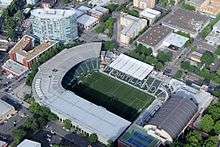
A few thousand seats were added for two games late in the 2011 season. About 2,000 seats were opened up for the 2012 season, bringing capacity up to 20,438. Following the 2012 season in which the Timbers' average attendance was 20,438, during the 2012–13 off-season the Timbers widened the pitch for the 2013 season, adding 2 yards (1.8 m) on each side to achieve a width of 74 yards (68 m).[27] The team widened the pitch by another yard in 2014, for a total pitch size of 110 by 75 yards (101 m × 69 m).[2]
2019
In April 2017, the Portland Timbers unveiled a US$85 million renovation plan which would add roughly 4,000 new seats to the eastern side of the stadium.[28] Timbers' President of Business Mike Golub stated that "We felt it was imperative to see how we could transform the stadium and add capacity to both meet the demand that we have for tickets and also position the club to be viable and competitive for years to come", referencing the Timbers' current season ticket waitlist of approximately 13,000. The renovation came at no cost to the City of Portland and brought the stadium to a capacity of 25,218, which was the 4th-highest of any soccer-specific venue in MLS.
The club partnered with Portland-based Allied Works Architecture to design the expansion,[29] and began construction in late 2017,[30] with the goal of having the renovated stadium ready in late May or early June of the 2019 MLS season.[31][29]
The stacked deck on the East End was the largest single seat expansion in Providence Park history. The new remade steel stand was inspired by the legendary Boca Juniors' stadium La Bombonera as well as the classic raised stage of Shakespeare's Globe Theatre, creating a unique layered appearance that also paid homage to the original, unfinished 1926 Multnomah Field plans.[32] Spelled out across the green seats on the East End in white lettering is "SC USA", a direct nod to Portland's history as "Soccer City USA".[33]
The expanded Providence Park opened for the first time on July 1, 2019 as the Timbers hosted LAFC, selling out the capacity of 25,218. Included in the privately funded $85 million renovation were the addition of three decks of new seats, two new video boards and a modern edge-to-edge roof, as well as updated LED lighting throughout the park.[34]
With the new renovation going swimmingly, the next step for the stadium appears to be getting a full grass field.[35] Timbers and Thorns owner Merritt Paulson has hinted that a grass field is next, and has even talked with Portland mayor Ted Wheeler about the logistics, but any planning would obviously be on hold as the MLS season was indefinitely postponed due to the COVID-19 pandemic.[36] A grass field to replace the turf could result in Providence Park being able to host USMNT or Olympic soccer games.
Current tenants
The stadium is currently home to the Portland Timbers of MLS, which the stadium has hosted in all of the club's iterations since 1975, and the Portland Thorns FC of NWSL since 2013.
Former tenants
In 1933, pari-mutuel betting was legalized in Oregon, and by May 23 of that year the Multnomah Kennel Club hosted its first greyhound race on the stadium's new track. The Kennel Club maintained its headquarters at the stadium until 1956, when the track was removed.[37]
The Portland Beavers minor league baseball team of the Pacific Coast League (PCL) had played some games at Multnomah Field during 1905 when their Vaughn Street Park was temporarily reconfigured to host a track and field event. They moved into Multnomah Stadium in 1956 after over a half century at Vaughn Street, a wooden ballpark which was soon demolished. The sod from the baseball field at Vaughn Street was transferred to the new venue; Civic Stadium installed artificial turf in 1969.
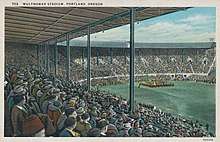
From 1973 to 1977 the independent Portland Mavericks of the Northwest League played their home games at the stadium. Actor Kurt Russell was an infielder for the Mavericks.[38] The Beavers returned to Portland in 1978 until 1993 when they were moved out of the city again. The Class A Portland Rockies were established in 1995 and played at the park until 2000 when they were moved and renamed the Tri-City Dust Devils. In 2001, the Albuquerque Dukes were moved to Portland and renamed the "Beavers" marking the third time the franchise would occupy the park for their home games.
As a baseball venue, the stadium had an unorthodox south-southeast alignment, with home plate in the northwest corner (20th and Morrison) of the property.
After it was announced that Major League Soccer was moving a franchise to Providence Park (then known as PGE Park) the Beavers baseball team had to start looking for a new stadium. However, the plan never came to fruition and team owner Merritt Paulson put the Beavers up for sale. The club's major-league parent, the San Diego Padres, purchased the team, which moved to Tucson, Arizona as the Tucson Padres. The team played its final game at the stadium on September 6, 2010.[39][40]
The stadium hosted the USFL's Portland Breakers, as well as the Portland Storm and Portland Thunder of the WFL.
Soccer has been hosted at Providence Park since the original Portland Timbers were founded in the original North American Soccer League in 1975. Various iterations of the team have called the stadium home, including the 1980s version in the Western Soccer Alliance and the 2000s version in the USL First Division before the MLS club was formed.
From 2008-2017, Providence Park was used as home for the Timbers U23s of the USL2, a development platform for the club. Following the 2017 season, the Portland U23s moved to Salem, OR.
Events
Soccer
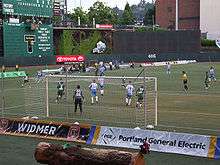
On August 28, 1977, the stadium was site of the North American Soccer League Soccer Bowl '77 between the New York Cosmos and the Seattle Sounders, the last official game of the legendary Pelé. The Cosmos won the championship.
On September 7, 1997 the stadium hosted a World Cup soccer qualifying match between the United States men's national team and Costa Rica. A raucous capacity crowd of 27,396 saw the U.S. squad win, 1–0, on a goal by Tab Ramos in the 79th minute.
The stadium was the site of four group matches in the 1999 Women's World Cup. The stadium also hosted two group matches, two quarterfinals, and both semifinals in the 2003 Women's World Cup.
On July 1, 2009, the venue hosted the third-round match of the Lamar Hunt U.S. Open Cup between the Portland Timbers and their rivals the Seattle Sounders FC.
Providence Park hosted the 2014 MLS All-Star Game.[41][42] Following the conclusion of the game, an incident between Caleb Porter, the manager of the Portland Timbers and the MLS All-Stars, and Pep Guardiola, the manager of Bayern Munich, drew headlines.[43] Guardiola refused to shake hands with Porter following the match and the two exchanged words, with Guardiola walking off the pitch angrily.
1999 FIFA Women's World Cup matches
Stadium was known as Civic Stadium
| Japan | 0–5 | |
|---|---|---|
| Report |
|
| China PR | 7–0 | |
|---|---|---|
|
Report |
| North Korea | 3–1 | |
|---|---|---|
|
Report |
|
2003 FIFA Women's World Cup matches
Stadium was known as PGE Park
| Germany | 7–1 | |
|---|---|---|
|
Report |
|
| United States | 0–3 | |
|---|---|---|
| Report |
|
2013 CONCACAF Gold Cup matches
Stadium was known as Jeld-Wen Field
2014 MLS All-Star Game
Stadium was known as Jeld-Wen Field
| MLS All-Stars | 2-1 | |
|---|---|---|
| Wright-Phillips Donovan |
Report | Lewandowski |
Baseball
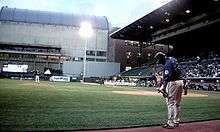
During the 1970s, the Jantzen swim wear company had a 3D model of the Jantzen girl hovering overby cable over the left field wall in its baseball configuration. The Jantzen girl was in play because it was below the top of the wall and it was hit a couple of times over the years.[45][46]
On May 27, 1991, the stadium received national attention when Vancouver Canadians outfielder Rodney McCray, while attempting to catch a fly ball, crashed through a wooden advertisement behind the warning track in right-center field; a real-life version of an incident in the fictional book and film, The Natural. While McCray failed to make the out, he only suffered scrapes and bruises and remained in the game. Highlight reels of that play ran for weeks on cable channels such as CNN and ESPN. On August 12, 2006, the Beavers commemorated the event with a Rodney McCray Bobblehead Night, passing out bobbleheads of McCray to fans and renaming right-center field "McCray Alley".[47]
In the mid-1990s the stadium was planned to be the home of the yet-to-be named Portland team, a charter franchise of the United League (UL) which was planned to be a third league of Major League Baseball (MLB).
On July 15, 2009, the stadium hosted the Triple-A All-Star Game, with the International League stars defeating the Pacific Coast league, 6–5. The game was attended by 16,637 fans, the largest crowd for a Triple-A All-Star game since 1991, and the third largest at the time.[48] Portland's Chad Huffman won the Home Run Derby.[49]
College football

Known as Multnomah Stadium at the time, the venue was formally dedicated on Oct. 9, 1926, as the University of Washington's football team beat the University of Oregon, 23-9, with more than 24,000 fans in attendance.[14]
The Providence Park all-time college football attendance record was set on October 18, 1930 as 35,266 fans watched the Oregon Ducks defeat their rival the Washington Huskies by a score of 7-0.[37]
Providence Park, then known as Civic Stadium, was home to many generations of high-octane offense from the Portland State Vikings, including from 1975 to 1980 when Mouse Davis, the "godfather" of the run and shoot offense and Portland State Football Hall of Famer, was the head coach of PSU.[50] While coaching at Civic, he led the PSU football program to a 42-24 record over six seasons while averaging 38 points and nearly 500 yards of offense per game. PSU led the nation in scoring three times.[50] The unique passing game made stars out of Davis' two main quarterbacks, June Jones and Neil Lomax. In 1975, Jones threw for a Division II record 3,518 yards. Davis' next quarterback, Lomax, set NCAA records of 13,220 yards and 106 touchdowns in 42 games. Under Davis' direction, Portland State set 20 NCAA Division II offensive records[50] in addition to the Vikings being named the NCAA's all-time point producers in 1980, scoring 541 points in 11 games for 49.2 points per game, along with 434.9 yards passing and 504.3 yards of total offense per game.
During a November 9, 1980 game, Lomax threw for seven first-quarter touchdowns against Delaware State, which the Vikings won 105-0.[14]
On October 27, 2007, the stadium hosted the highest-scoring game in modern NCAA football history, when the Weber State University Wildcats defeated the PSU Vikings, 73–68, a combined point total of 141 points. This point total eclipsed the previous NCAA record of 136 points, set in a 1968 Division III game, and the previous Division I record of 133 points, set in 2004.[51] While this record lasted only two weeks, and has been surpassed four times in all, it remained the highest-scoring game involving NCAA Division I teams until 2018, when Texas A&M defeated LSU in a 74–72 seven-overtime game. Coincidentally, Mouse Davis was the offensive coordinator for Portland State at the time, returning to Providence Park under the head coaching of Jerry Glanville.
Concerts
While on a four-day tour of the Pacific Northwest, September 2, 1957, Elvis Presley performed in one of the first three outdoor stadium rock concerts in music history (Presley had held the second ever in Vancouver, BC, Canada just a few days earlier, on September 1, 1957 at Empire Stadium, his first being at the Cotton Bowl, in Dallas RX, on 11 October 1956. The concert created mass hysteria and an estimated 14,600 people attended the concert.[52][53]
In a November 8, 2013 interview with the Portland Business Journal,[52][53] Portland Timbers owner Merritt Paulson expressed his desire to host summer concerts at the stadium.
| Date | Artist | Opening act(s) | Tour / Concert name | Attendance | Notes | Revenue |
|---|---|---|---|---|---|---|
| September 2, 1957 | Elvis Presley | - | - | — | — | |
| June 13-14, 1970 | Big Brother and the Holding Company | - | - | — | — | |
| July 28, 1984 | The Beach Boys | - | - | — | — | |
| June 2, 1985 | Jimmy Buffett | - | Sleepless Knights Tour | — | — | |
| July 29, 1986 | Bob Dylan & Tom Petty | - | True Confessions Tour | — | — | |
| August 30, 1986 | The Monkees | - | 20th Anniversary Tour | — | — | |
| August 14, 1987 | David Bowie | - | Glass Spider Tour | — | — | |
| August 21, 1992 | Jimmy Buffett | - | Recession Recess | — | — | |
| September 25, 1992 | Johnny Cash | - | - | — | — | |
| July 5, 1994 | James Taylor | - | - | — | — | |
| September 4, 1994 | Spin Doctors | Cracker and Gin Blossoms | - | — | — | |
| April 4, 1995 | Sarah McLachlan | - | - | — | — | |
| July 1, 1995 | Village People | - | - | — | — | |
| September 15, 1995 | Van Halen | Our Lady Peace | The Balance "Ambulance" Tour | — | — | |
| July 14. 1996 | Crosby, Stills & Nash | Chicago | - | — | — | |
| June 19, 1998 | Sinead O'Connor | - | - | — | Lilith Fair | |
| June 19, 1998 | K's Choice | - | - | — | Lilith Fair | |
| June 19, 1998 | Sarah McLachlan | - | - | — | Lilith Fair | |
| June 19, 1998 | Erykah Badu | - | - | — | Lilith Fair | |
| June 19, 1998 | Indigo Girls | - | - | — | Lilith Fair | |
| June 19, 1998 | Natalie Merchant | - | - | — | Lilith Fair | |
| June 19, 1998 | Billie Myers | - | - | — | Lilith Fair | |
| July 11, 1999 | Beth Orton | - | - | — | Lilith Fair | |
| July 11, 1999 | Luscious Jackson | - | - | — | Lilith Fair | |
| July 11, 1999 | Bijou Phillips | - | - | — | Lilith Fair | |
| July 11, 1999 | Sandra Bernhard | - | - | — | Lilith Fair | |
| July 11, 1999 | Mýa | - | - | — | Lilith Fair | |
| July 11, 1999 | Sarah McLachlan | - | - | — | Lilith Fair | |
| July 11, 1999 | Sixpence None the Richer | - | - | — | Lilith Fair | |
| July 11, 1999 | Sheryl Crow | - | - | — | Lilith Fair | |
| July 11, 1999 | Liz Phair | - | - | — | Lilith Fair | |
| June 1, 2005 | Def Leppard | Bryan Adams | Rock 'N Roll Double Header Tour | — | — | |
| June 7, 2005 | Joan Jett | - | - | — | — | |
Art and design
Providence Park's outside walls are covered with naturally-grown ivy.[54] The entrance billboard used to announce dates and future games is a deliberate retro replica of the old scoreboard that used to be in the same location.[54]
Multiple art installations and sculptures line the outside plazas of Providence Park. Those include Facing the Crowd, a series of two bronze sculptures, and You Are Here, a artistic rendition of a 12-foot wide log ring with historical artifacts of Portland's past embedded inside.
In popular culture
In 2010, Providence Park was a filming location of Season 2 of the television series Leverage. The episode depicts a fictional Massachusetts (where the series was set) minor league team also known as the Beavers.[55]
The IFC show Portlandia references Providence Park multiple times throughout the series and the lead characters Peter (Fred Armisen) and Nance (Carrie Brownstein) attend a Timbers match in a 2012 episode, bringing along a home-made sign to root for the club.[56]
Feral cat colony
Since approximately 1985, the field has been home to a feral cat colony,[57] which may have been at the park before the current stadium opened in 1926.[58] There are an estimated 12–19 cats in the colony,[57] referred to as "living rat traps".[59] After a construction worker killed a feral cat in 2000,[58] the park enlisted the Feral Cat Coalition of Oregon to assist the animals during construction efforts and to run a trap-neuter-return program.[57] The cats are discussed in Chuck Palahniuk's travelogue of Portland, Fugitives and Refugees.[57][58]
Gallery
 The stadium photographed from the street in 1930
The stadium photographed from the street in 1930 An aerial view of the stadium in 1956
An aerial view of the stadium in 1956- An aerial view of the stadium in 1969
- An aerial view of the stadium in 1974
- The stadium photographed towards the north end in 1974
 The east entrance to the stadium in 2008
The east entrance to the stadium in 2008 A man watches a Timbers match in 2014
A man watches a Timbers match in 2014
See also
- List of sports venues in Portland, Oregon
- List of NCAA Division I FCS football stadiums
- Portland Beavers Ballpark, a proposed stadium in 2010
- Vaughn Street Park, a now-demolished baseball park
References
- Prince, Tracy J. (2011). Portland's Goose Hollow. Charleston, South Carolina: Arcadia Publishing. p. 2. ISBN 978-0-7385-7472-1.
- Orr, Michael A. (December 31, 2013). "Timbers Expanding Width of Field to 75 Yards". Retrieved January 1, 2014.
- "Multnomah Stadium Acquisition Bonds" (PDF). pdxcityclub.org. November 8, 1966. Archived from the original (PDF) on March 9, 2011. Retrieved April 21, 2012.
- "October 9, 1926: Multnomah Civic Stadium is Dedicated". Dave Knows Portland. Retrieved January 16, 2016.
- Federal Reserve Bank of Minneapolis. "Consumer Price Index (estimate) 1800–". Retrieved January 1, 2020.
- "Merritt Paulson's vision comes to fruition as Portland Timbers prepare to reopen renovated Providence Park". May 30, 2019. Archived from the original on May 30, 2019. Retrieved February 27, 2020.
- Multnomah County OR Archives Biographies – Hansen, L. W.
- Goldberg, Jamie (February 10, 2014). "Portland Timbers to rename their stadium Providence Park". The Oregonian. Retrieved February 10, 2014.
- "Timbers, Thorns FC recognized by Portland Business Journal with Commercial Real Estate Transformer Award". November 21, 2019. Retrieved May 25, 2020.
- "Vikings Play At Jeld-Wen Field In 2011".
- "PGE Park renamed Jeld-Wen Field".
- "Civic Stadium". Oregon Historical Society. Archived from the original on January 4, 2006. Retrieved April 27, 2011.
- "Multnomah Stadium". www.oregonencyclopedia.org. Retrieved January 16, 2016.
- "PROVIDENCE PARK: A PORTLAND LANDMARK SINCE 1926". May 25, 2020. Retrieved May 25, 2020.
- Quick, Jason (February 11, 2014). "Issues and Answers: No matter what the stadium is called, Providence Park is a place where memories are made". The Oregonian. Retrieved August 7, 2014.
It was built in 1926 by what is now the Multnomah Athletic Club for $502,000 and called Multnomah Civic Stadium. In 1966, it was sold to the city of Portland for $2.1 million, and became known as Civic Stadium. In 2001, it became PGE Park and in 2011 Jeld-Wen Field.
- "Timbers rename home stadium JELD-WEN Field" (Press release). Portland Timbers. March 14, 2011. Archived from the original on March 18, 2011. Retrieved April 27, 2011.
- "MA Short History of the Stadium's Footprint and East Side Expansions". April 28, 2017. Retrieved May 25, 2020.
- "Measures & Initiatives 1980 to 1989". May 25, 2020. Retrieved May 25, 2020.
- "City of Portland Oregon: Limited Tax Revenue Bonds (Oregon Convention Center Completion Project)". May 25, 2020. Retrieved May 25, 2020.
- Orr, Michael. "A Short History of the Stadium's Footprint and East Side Expansions". Stumptown Footy. Retrieved May 25, 2020.
- Larabee, Mark (June 24, 2009). "Major League Soccer plan still alive as Portland council endorses latest plan". The Oregonian. Retrieved June 25, 2009.
- Haberman, Margaret (July 23, 2009). "$31 million PGE Park renovation passes 4–1". The Oregonian. Retrieved April 18, 2011.
- Jug, Helen (August 5, 2009). "Vision for PGE Park: A place that says 'soccer'". The Oregonian. Archived from the original on March 11, 2011. Retrieved April 18, 2011.
- "Lighthouse and TS Sports Make an Impact with LED Video at Portland's Jeld Wen Field". May 17, 2011. Archived from the original on September 9, 2011. Retrieved August 21, 2011.
- Neves, Randy (March 3, 2011). "PGE Park project $5 million over budget". KGW. Archived from the original on January 17, 2012. Retrieved July 2, 2011.
- "PGE Park would have similar capacity under soccer remodel, designers say". The Oregonian. September 22, 2009. Retrieved April 18, 2011.
- Arnold, Geoffrey C. (August 28, 2012). "Portland Timbers to widen field for 2013 season". Retrieved January 7, 2013.
- Timbers.com Staff (April 26, 2017). "A soccer cathedral grows: Providence Park to add approximately 4,000 new seats in modern expansion | Portland Timbers". Timbers.com. Retrieved April 29, 2017.
- Goldberg, Jaime (April 26, 2017). "Portland Timbers unveil $50 million stadium expansion plan for Providence Park". The Oregonian. Retrieved April 27, 2017.
- Goldberg, Jamie (January 11, 2018). "Providence Park stadium expansion construction is underway and on schedule". The Oregonian. Retrieved April 23, 2019.
- Goldberg, Jamie. "Portland Timbers expect to play first 12 games on the road in 2019 due to construction at Providence Park". oregonlive.com. Retrieved January 25, 2019.
- "Just let me look: Inside story of how Timbers' stadium renovations started". May 30, 2019. Retrieved May 25, 2020.
- "Boehm: How Providence Park became sacred ground for Portland and their fans". May 31, 2019.
- "A first look at the new-and-improved Providence Park for Portland Timbers and Thorns". May 8, 2019. Retrieved May 25, 2020.
- "For a sign that MLS growth is exerting pressure on more established teams, look to Portland's stadium renovations". April 25, 2019. Retrieved August 1, 2020.
- "Grass field at Portland's Providence Park? It could happen". January 29, 2019. Retrieved August 1, 2020.
- "Multnomah Stadium". May 25, 2020. Retrieved May 25, 2020.
- "Kurt Russell Minor League Statistics & History". Baseball-Reference.com. Retrieved February 13, 2014.
- "Portland Beavers Moving to Tucson".
- Larabee, Mark (May 29, 2009). "Beavers Must Move Out of PGE Park, League Says". The Oregonian. Retrieved September 13, 2009.
- Arnold, Geoffrey C. (July 11, 2013). "Portland to host 2014 MLS All-Star Game". The Oregonian. Retrieved July 11, 2013.
- "Portland to host 2014 All Star Game". StadiaDirectory.com. Archived from the original on July 19, 2013. Retrieved July 11, 2013.
- "MLS All-Star Game: Pep Guardiola Eventually Shakes Caleb Porter's Hand". August 6, 2014. Retrieved August 1, 2020.
- "FIFA Women's World Cup USA 2003 – Report and Statistics" (PDF). FIFA.com. Fédération Internationale de Football Association. pp. 93–100. Retrieved January 7, 2020.
- "OSU in Portland". Kyle Odegard. Retrieved June 23, 2009.
- The Portland Beavers. Arcadia Publishing, page 82. August 2004. ISBN 978-0-7385-3266-0. Retrieved June 23, 2009.
- Bachman, Rachel (August 12, 2006). "An effort at de-fence worth remembering". The Oregonian. Retrieved January 21, 2007.
- "Triple-A All-Star Game Results (2008–2012)". Triple-A Baseball. Retrieved July 7, 2017.
- "Triple-A All-Star Home Run Derby Winners". 2017 Pacific Coast League Sketch & Record Book. Pacific Coast League. 2017. p. 162.
- Schlabach, Mark (July 20, 2009). "Spread concepts around for decades". ESPN.com. Retrieved July 21, 2009.
- "Weber State football: Wildcats earn record-setting win". Associated Press. October 28, 2007. Archived from the original on February 6, 2008. Retrieved October 29, 2007.
- "Elvis Presley: Multnomah Civic Stadium Portland, OR : September 2, 1957". Retrieved January 16, 2016.
- "Scotty Moore – Multnomah Civic Stadium – Portland, OR". Retrieved January 16, 2016.
- "Providence Park (Portland, Oregon)". August 1, 2020. Retrieved August 1, 2020.
- "'Leverage' turns Portland into 'Beantown West'". OregonLive.com. Retrieved January 16, 2016.
- ""Portlandia" Heads to a Timbers Game". February 27, 2012. Retrieved August 1, 2020.
- Balas, Monique (April 11, 2011). "Jeld-Wen Field crews take care of feral cat colony while getting ready for the Portland Timbers". The Oregonian. Retrieved April 11, 2011.
- Palahniuk, Chuck (2003). Fugitives and Refugees: A Walk in Portland, Oregon. New York: Crown Journeys. pp. 153–155. ISBN 1-4000-4783-8.
- Hunt, John (June 12, 2009). "Portland Beavers' Ken Puckett nearing milestone (1,000 consecutive events) for durability". The Oregonian. Retrieved April 11, 2011.
External links
| Wikimedia Commons has media related to Providence Park. |
- Official website
- Providence Park at StadiumDB.com
- Portland State Athletic Facilities
- Jeld-Wen Field Virtual Venue
- PGE Park Views – Ball Parks of the Minor Leagues